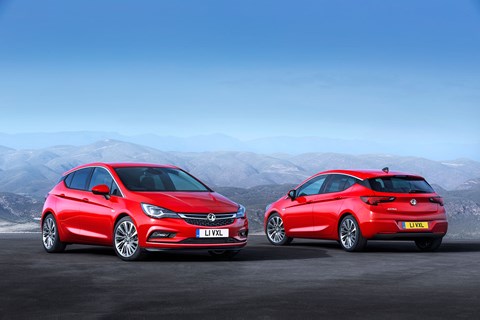► Full pictures, news and specs of 2015 Astra
► It’s Vauxhall and Opel’s seventh-generation hatch
► Smaller on the outside, bigger on the inside
Vauxhall and sister brand Opel continue to renew their model ranges at a startling pace; no sooner have we driven the latest Corsa and Viva than GM’s European arm shows the new 2015 Astra, complete with Germanic surfacing and trick D-pillar styling.
It’s the British-built rival to the likes of the Ford Focus and VW Golf – and as well as a slicker, fresher design there’s plenty of technical change under the skin. Like a 200kg weight saving. Better smartphone integration. And a suite of new, fuel-efficient engines.
Is that enough though, in a marketplace seemingly obsessed by posh branding and Germanic, aspirational badges? Snob appeal has always been the Astra’s Achilles’ heel, after all… Read on for a full dossier on the new Vauxhall Astra. And click here for CAR magazine’s early drive of a prototype.
Overview
The new 2015 Astra continues a theme we often see nowadays: it’s smaller on the outside but more spacious inside, with 35mm extra rear legroom claimed. Such are the vagaries of computer-aided design, GM’s engineers have managed to sculpt out more passenger room within a slightly smaller footprint.

And that shrunk-in-the-hotwash architecture brings benefits. Vauxhall claims it’s up to 200kg lighter than the outgoing model, to the benefit of performance, economy, handling, braking – everything, really.
It also means that smaller engines can be fitted. The average weight saving (as opposed to maximum, lard-bottomed one quoted above) is 130kg, achieved by a 20% reduction in the mass of the Astra’s bodyshell, down to 280kg. And lightweight components in the chassis shave a further 50 kilos from the suspension and drivetrain.
There’s no clever-clogs composites or carbonfibres at play here; instead Vauxhall and Opel have deployed more expensive, high-strength steels in relevant areas, giving extra strength but thinner metal in key stress areas.
Vauxhall Astra engines, specs
There’s a wide range of new engines fitted to the 2015 Astra. Power outputs stretch from 99bhp to 197bhp and, although the full spec has not yet been issued, key motors include:
- 1.4-litre 4cyl petrol 143bhp, direct-injection turbo
- 1.0-litre 3cyl petrol 104bhp direct-injection turbo
- 1.6-litre 4cyl diesel from 109bhp to 158bhp
More details will be issued in the coming weeks; we expect a red-hot VXR to crown the range in due course.
Design story
The Astra’s footprint is much smaller than before; at 4370mm long, it’s 5cm shorter than the Mk6 Astra, as well as 2.6cm – an inch – lower. Vauxhall quotes an aerodynamic drag figure of 0.30, impressive for a Focus-class mid-sized hatchback.

The wheelbase is shrunk, too, with 2cm less between the axles before – which makes the roomier passenger cell all the more impressive. Is the new wardrobe a success? We’re sure you’ll tell us in the comments below, but to these eyes it’s very Vauxhall-similar from the front, with a little more extra visual drama at the rear, where you’ll find a trick criss-cross D-pillar for a ‘floating roof’ vibe (according to GM), as well as decidedly BMW 1-series-spec rear lamps and crisply-surfaced tailgate.
Inside is a new 8in touchscreen, designed to sync seamlessly with Apple CarPlay or Android Auto smartphone systems for streaming music, services and apps via the car’s display. And this is the first Vauxhall available with OnStar connectivity from launch.
Note also the LED headlamp system which, like Mercedes’, uses cameras to manage the throw of the light beam; in essence, full beam is always on, but its shape is controlled to avoid blinding oncoming vehicles. The Astra packs a lot of executive toys into its spec (although many remain options, naturally) – including 18-way adjustable electric chairs, self-parking and lane-keep assist.
Background
The Astra continues to prove popular with buyers, and is the company’s second best-selling model in the UK after the Corsa. An impressive 2.9 million Astras have been sold in the UK in the past 36 years – including more than 50,000 in 2014.
See the new, seventh-generation Astra in the metal at the 2015 Frankfurt motor show in September.
